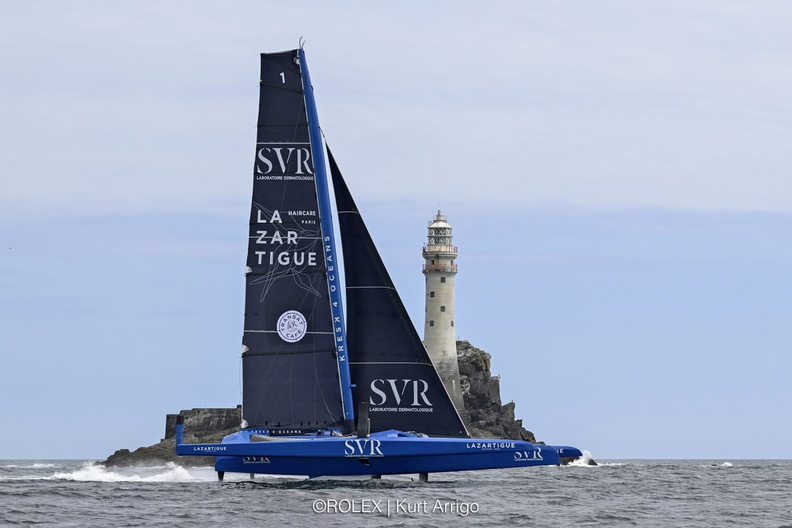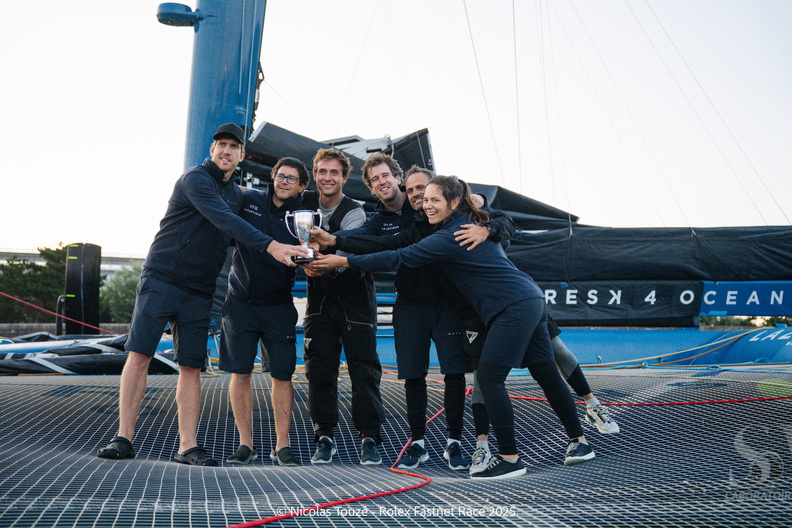
On Saturday, July 26, 2025, the Rolex Fastnet Race burst back to life, celebrating its 100th anniversary with the biggest fleet in its history. An incredible 444 boats crossed the Royal Yacht Squadron’s start line off Cowes, the same stretch of Solent waters where it all began in 1925, under a brooding sky and a teasing 10 - 12 knot southwesterly breeze.
The numbers were staggering, with over 2,900 sailors, a century of racing legacy, and a course as unforgiving as it is legendary.
With thousands lining the shoreline and the Red Arrows flying overhead, Cowes came alive. From the packed Green to the balconies of the Royal Yacht Squadron, spectators watched wave after wave of boats take off between 11:20 and 13:20 BST. A royal visit from Princess Anne added gravity to the moment, but it was the scale and diversity of the fleet that truly stole the show.
In the multihull classes, the U.S. MOD70 Argo made headlines. Jason Carroll’s team blasted out of the Solent, ahead of French powerhouses SVR Lazartigue, Inter Invest, and Koesio. But the Ultims quickly struck back. By the time the leaders reached Portland Bill, the pace was blistering and SVR Lazartigue was back in contention.
Meanwhile, the IMOCA fleet (the Formula One of offshore sailing) delivered drama of its own. Swiss skipper Justin Mettraux aboard Teamwork SNEF edged ahead of rising star Elodie Bonafous and veteran Yoann Richomme. On his tenth Fastnet, Richomme summed it up: “Just sail to a rock off Ireland and back.” It might sound simple, until you’re doing it at 30+ knots with foils skimming the waves.
By Monday morning, the Ultims had taken off. At 04:38 BST, SVR Lazartigue, helmed by the composed Tom Laperche, 27 years old, crossed the finish line in Cherbourg after just 1 day, 17 hours, 18 minutes, and 4 seconds at sea.
It was Laperche’s first outright Fastnet win as lead skipper, and what a statement. Racing alongside legends like Franck Cammas and Peter Burling, he delivered calm, clever sailing through challenging conditions: erratic breeze, a rough Irish Sea, and a high-risk gybe-fest back to France. “It was a real regatta,” said Laperche afterward.
Close behind were Banque Populaire XI and Actual Ultim 4, continuing French dominance in the foiling classes.

While the foilers grabbed the spotlight, the Admiral’s Cup fleet quietly reshaped its own legacy. Racing kicked off on Sunday, July 27, and rivalries reignited quickly. Jolt 3 (Carkeek 45) surged ahead in the AC1 class, while in AC2, Giovanni Lombardi Stronati’s Django (JPK 1180) navigated the tides to perfection. With a refreshed format and tight scoring, one could feel that this was the beginning of something new.
The finish in Cherbourg - now confirmed for 2025 and 2027, offered the perfect ending to a modern epic. With cutting-edge tech support from B&G and thousands lining the docks, France once again proved it can host world-class offshore racing at scale.
This year’s roster read like a who’s who of elite sailing: Tom Laperche, Peter Burling, Yoann Richomme, Pierre Casiraghi, all competing across multihull and monohull divisions. With fleets including IMOCA 60s, Class40s, and IRC monohulls, the display of talent and technology was unmatched.
With the Admiral’s Cup ongoing and IRC results rolling in, one thing is certain: the centenary edition has lived up to, and exceeded expectations. Yes, SVR Lazartigue claimed early glory, but with the monohull title still undecided and class battles raging, this Fastnet is far from finished.
The Rolex Fastnet Race may be 100 years old, but this edition proved it’s still one of the most exciting events in global sport. Fast boats, bold personalities, high stakes, and tactical brilliance all wrapped into one unforgettable offshore contest. The Fastnet Race has once again shown why every sailor dreams of winning it, and every fan loves to follow it.